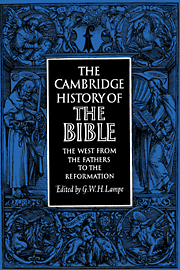Book contents
- Frontmatter
- I The Old Testament: Manuscripts, Text and Versions
- II The History of the Text and Canon of the New Testament to Jerome
- III Early Christian Book-Production: Papyri and Manuscripts
- IV Jerome
- V The Medieval History of the Latin Vulgate
- VI The Exposition and Exegesis of Scripture
- VII The ‘People's Bible’: Artists and Commentators
- VIII Bible Illustration in Medieval Manuscripts
- IX The Vernacular Scriptures
- X Erasmus in Relation to the Medieval Biblical Tradition
- Bibliography
- Notes on the Plates
- Index
- References
V - The Medieval History of the Latin Vulgate
Published online by Cambridge University Press: 28 March 2008
- Frontmatter
- I The Old Testament: Manuscripts, Text and Versions
- II The History of the Text and Canon of the New Testament to Jerome
- III Early Christian Book-Production: Papyri and Manuscripts
- IV Jerome
- V The Medieval History of the Latin Vulgate
- VI The Exposition and Exegesis of Scripture
- VII The ‘People's Bible’: Artists and Commentators
- VIII Bible Illustration in Medieval Manuscripts
- IX The Vernacular Scriptures
- X Erasmus in Relation to the Medieval Biblical Tradition
- Bibliography
- Notes on the Plates
- Index
- References
Summary
In a letter written to Jerome in 403, Augustine mentioned that in Eoa (Tripoli) a bishop had caused a disturbance, and had nearly lost his flock, through reading a lesson from Jonah in Jerome's new Latin version. Jerome replied that the trouble was doubtless due to his improved rendering of the Hebrew qiqqayon (gourd), for which he had replaced the earlier cucurbita by hedera, itself admittedly not a perfect rendering. The incident is a fair example of perhaps the most formidable kind of opposition against which any revised or new translation of the Scriptures may have to struggle: if the student is to appreciate adequately the forces at play, it is essential for him to gain some insight into the minds of the laity as well as the scholars and theologians ranged for or against innovation. As for the case in point, we may remind ourselves of the widespread recognition in Jonah and his experiences of a type of Christ, and there are plentiful examples from the second century onwards of Jonah's frequent representation in early Christian iconography. These reflect the strength of the popular notion of the plant that shaded Jonah as a gourd, a notion too sturdy to give way before Jerome's proposed ivy—a point with which Rufinus, in castigating Jerome, makes sarcastic play. With one doubtful exception, the surviving monuments will have none of the ivy, tout simple; they show either the plain gourd, or compromise with a hybrid invention exhibiting features of both gourd and ivy.
- Type
- Chapter
- Information
- The Cambridge History of the Bible , pp. 102 - 154Publisher: Cambridge University PressPrint publication year: 1969
References
- 7
- Cited by



